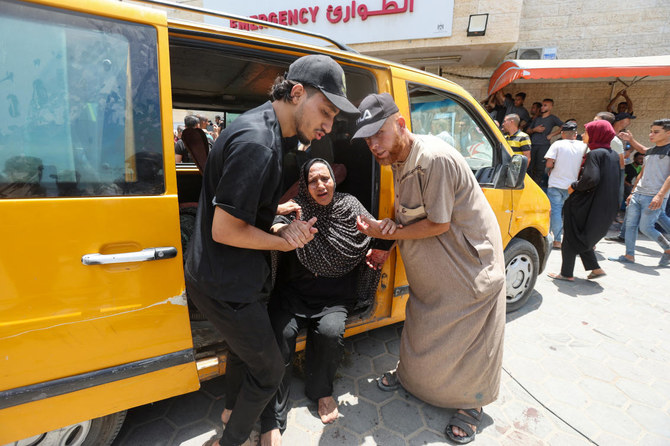CAIRO: Israeli forces pounded central Gaza anew on Sunday, a day after killing 274 Palestinians during a hostage rescue raid, and tanks advanced into further into Rafah in an apparent bid to seal off part of the southern city, residents and Hamas media said.
Palestinians remained in shock over Saturday’s death toll, the worst over a 24-hour period of the Gaza war for months and including many women and children, Palestinian medics said.
In an update on Sunday, Gaza’s health ministry said 274 Palestinians were killed — up from 210 it reported on Saturday — and 698 were injured when Israeli special force commandos stormed into the densely populated Al-Nuseirat camp to rescue four hostages held since October by Hamas militants.
Sixty-four of the dead were children and 57 were women, the Hamas-run Gaza government media office said on Sunday.
Israel’s military said a special forces officer was killed in exchanges of fire with militants emerging from cover in residential blocks, and that it knew of “under 100” Palestinians killed, though not how many of them were fighters or civilians.
In central Gaza on Sunday, separate Israeli airstrikes on houses in the city of Deir Al-Balah and in nearby Al-Bureij killed three Palestinians in each location, while tanks shelled parts of Al-Nuseirat and Al-Maghazi, medics said.
Al-Maghazi, Al-Nuseirat and Al-Bureij are historic, urbanized refugee camps often caught up in the current war.
The Israeli military said in a statement its forces were continuing operations east of Al-Bureij and Deir Al-Balah, killing a number of Palestinian gunmen and destroying militant infrastructure.
Israel sent forces into Rafah in May in what it called a mission to wipe out Hamas’ last intact combat units after eight months of war, in which Israeli forces have bombed much of the rest of Gaza to rubble while advancing against fierce resistance from militants embedded in crowded cities and built-up camps.
Israeli tank forces have since seized Gaza’s entire border strip with Egypt running through Rafah to the Mediterranean coast and invaded many districts of the city of 280,000 residents, prompting around one million displaced people who had been sheltering in Rafah to flee elsewhere.
ISRAELI TANKS ADVANCE FURTHER IN RAFAH
On Sunday, tanks advanced into two new districts in an apparent effort to complete the encirclement of the entire eastern side of Rafah, touching off clashes with dug-in Hamas-led armed groups, according to residents trapped in their homes.
As of June 5, all but around 100,000 displaced people who took refuge in eastern Rafah after taking flight from Israeli offensives further north in Gaza had left, according to the UN agency for Palestinian refugees UNRWA.
“All UNRWA shelters in Rafah have been vacated. Many of the people who were based in Rafah have fled up the coast seeking safer locations in both Khan Younis and the middle area (of Gaza),” UNRWA said in a statement.
Palestinian medics said an Israeli airstrike on a house in Tel Al-Sultan in western Rafah killed two people.
The Israeli military said troops of its 162nd division were raiding some districts of Rafah where they had located “numerous additional terror tunnel shafts, mortars, and (other) weapons” belonging to Palestinian Islamist militants.
Hamas precipitated the war with a lightning cross-border attack into Israel last Oct. 7, killing around 1,200 people and seizing over 250 hostages, according to Israeli tallies. About half the hostages were freed during a brief November truce.
Israel’s ensuing air and ground war in Gaza has killed at least 37,084 Palestinians, the health ministry in the Hamas-run territory said in its Sunday update. The ministry says thousands more dead are feared buried under the rubble.
Attempts by the United States and regional countries to broker a deal that would release all remaining hostages in return for a ceasefire have repeatedly stumbled on Israeli and Hamas intransigence over terms for an end to the war.
A humanitarian catastrophe has unfolded as the war has dragged on, with over three-quarters of Gaza’s 2.3 million population displaced, malnutrition widespread and basic infrastructure in ruins.
Gaza’s conflict has destabilized the wider Middle East, drawing in Hamas’ main supporter Iran and its Lebanese ally Hezbollah, which has been clashing with Israel along its northern border for months, raising fears of all-out war.
Concern about an escalation in Israeli-Hezbollah hostilities and a sharp decline in expectations of a Gaza ceasefire have weakened Israel’s shekel currency by 3 percent to 3.75 to the dollar since June 4.


























